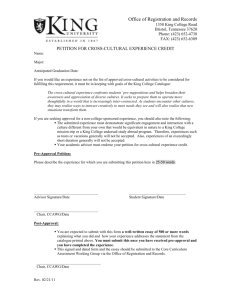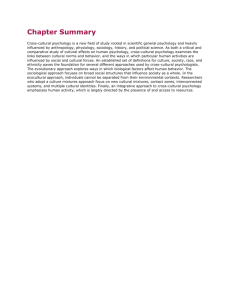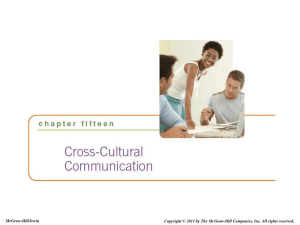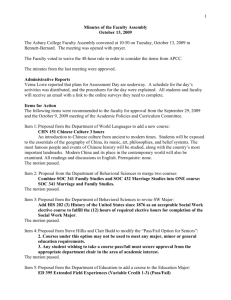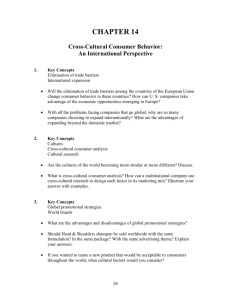Developing Cross-Cultural Corporate Global
advertisement
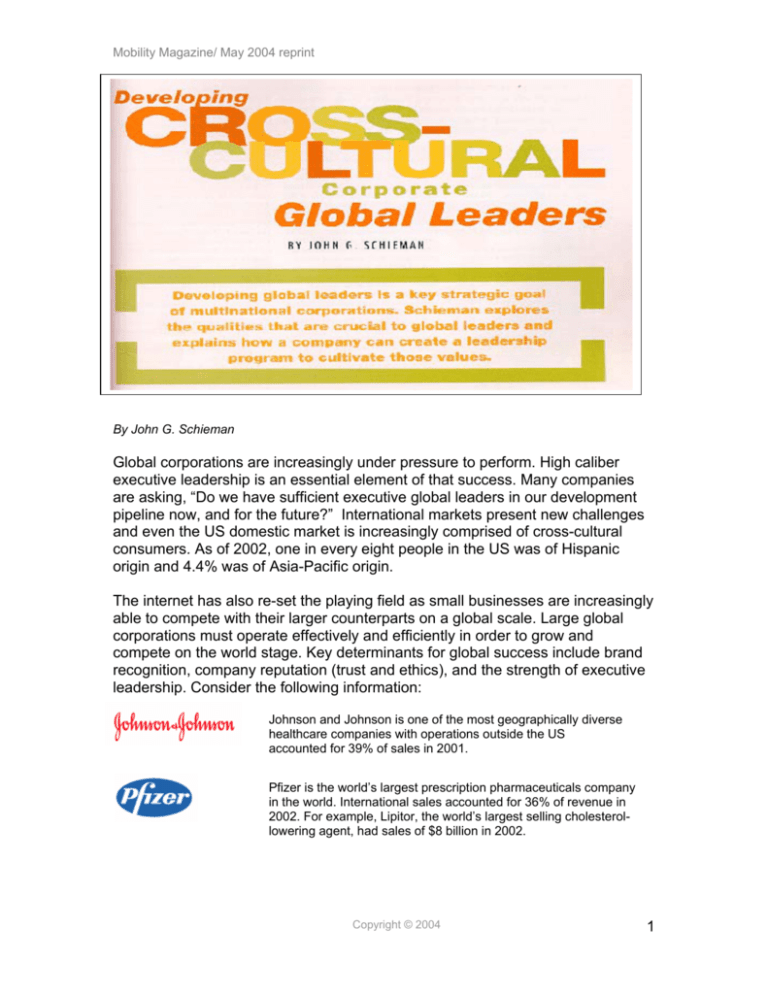
Mobility Magazine/ May 2004 reprint By John G. Schieman Global corporations are increasingly under pressure to perform. High caliber executive leadership is an essential element of that success. Many companies are asking, “Do we have sufficient executive global leaders in our development pipeline now, and for the future?” International markets present new challenges and even the US domestic market is increasingly comprised of cross-cultural consumers. As of 2002, one in every eight people in the US was of Hispanic origin and 4.4% was of Asia-Pacific origin. The internet has also re-set the playing field as small businesses are increasingly able to compete with their larger counterparts on a global scale. Large global corporations must operate effectively and efficiently in order to grow and compete on the world stage. Key determinants for global success include brand recognition, company reputation (trust and ethics), and the strength of executive leadership. Consider the following information: Johnson and Johnson is one of the most geographically diverse healthcare companies with operations outside the US accounted for 39% of sales in 2001. Pfizer is the world’s largest prescription pharmaceuticals company in the world. International sales accounted for 36% of revenue in 2002. For example, Lipitor, the world’s largest selling cholesterollowering agent, had sales of $8 billion in 2002. Copyright © 2004 1 Mobility Magazine/ May 2004 reprint Coca-Cola is the world’s largest producer of soft drink concentrates, syrups, and sodas sold in over 200 countries. Sales and operating profit in 2002 by geographic region were: • North America - 38% of revenue, 24% of profit • Europe, Eurasia, and the Middle East - 23% of revenue, 25% of profit • Latin America - 11% of revenue, 18% of profit • Africa - 3% of revenue, 4% of profit P&G goal is to create the most successful global brands in every category everywhere it competes. P&G manufactures 250 brands of consumer products in more than 140 countries. P&G has initiated a global restructuring project, Organization 2005. For full year 2002. • North America accounted for 57% of total sales • Europe, Middle East, Africa accounted for 26% of sales • Asia accounted for 10% of sales • Latin America accounted for 7% of sales Citigroup operated in more than 100 countries and territories as of 2002. The Citigroup Global Consumer Group, consisting of Citibanking, Cards, CitiCapital, CitiFinancial, and Primerica experienced record results in 2002. Walmart is the largest retailer in North America and now has its sights on the rest of the world. Internationally as of Q1, 2003, Walmart operates: • 561 units in Mexico, 196 in Canada, 15 in Puerto Rico • 252 in the UK • 11 in Argentina, 22 in Brazil, 95 in Germany • joint venture agreements, 19 in China and 10 in South Korea • international sales in 2002 were $35.5 billion, an increase of 10.5% from prior year. These statistics only begin to quantify the degree to which companies depend on global markets. Consider the future, the Asia-Pacific region represents 60% of the world’s population and 1.2 billion people in that region will have disposable income by 2020. Executive global leadership is an essential element for corporations to compete effectively in the world marketplace today, and more importantly - tomorrow. Critical Success Factors for every global corporation must include the ability to: • attract, develop, retain, and deploy the best talent worldwide • develop current and future global leaders Consider the following examples: • A major US healthcare corporation recruits Asia-Pacific Nationals who are attending MBA programs at the top US colleges and universities. The recruits enter a accelerated management training program in the corporate office, are assigned a key executive mentor, enter a wellCopyright © 2004 2 Mobility Magazine/ May 2004 reprint • • structured two year rotation plan, and are provided cross-cultural training. The overall objective is to re-assign these future leaders into major leadership positions in their country of origin. A major US manufacturing corporation requires all future global leader candidates to successfully complete one two-year international assignment in Latin America and one in either Europe or the Asia-Pacific region. A major Japanese financial services corporation requires future leaders to accept a three-year assignment in the US. A strategic part of the program is to purchase US products and experience customer service touch points in order to better understand the competition. The focus of this article is on developing the essential cross-cultural competencies of global leadership, identifying leadership characteristics and recommending a strategy on “how to acquire them”. Leadership Characteristics Vision – Leaders should have well-developed, clearly understood visions for the corporation. The vision needs to communicate what the corporation stands for and what the plan is for the future. Without clarity, visions are misunderstood and are less likely to succeed For example, the General Electric Corporation is committed to achieving worldwide leadership in each of its businesses. Jeffrey R. Immelt clearly articulated that as part of the GE vision (GE 2002 Annual report p. 6-8). That statement described “what” GE wanted to become. Another example is Hank McKinnell’s vision for Pfizer, “By working together with others, we can do more good for more people than any other company on the planet” (Pfizer 2002 Annual Report p. 13). With regard to cross-cultural competence, elements of the vision might include entry into emerging markets and new global products and sales initiatives. Most important would be a clear commitment to cross-cultural values and the strength that comes from cultural diversity. Strategy – Well understood visions must be supported by attainable, measurable strategies and action plans in order to succeed. To continue with the General Electric example, one of their five strategies is “Globalization as a way to grow faster and be more competitive.” That begins to clarify the “how” to achieve the vision. Copyright © 2004 3 Mobility Magazine/ May 2004 reprint The execution of the GE strategy included building the John F. Welch Technology Center in Bangalore, India, completed in 2000. The center supports 1,800 engineers, 25% with PhDs. Engineers at that facility created a working model of GE Plastics Plant in Spain. Working together, the two countries (and cultures) found a way to boost output by 20%.1 With regard to cross-cultural competence, strategic elements could include developing a detailed understanding of the individual cultures with regard to: • how to leverage China’s manufacturing advantage or India’s service delivery advantage. • cross-cultural product acceptance criteria • culture-specific product packaging (e.g. choice of color, use of numbers and symbols) • culture-specific marketing and advertising effectiveness (e.g. Asia-Pacific cultures advertisement might emphasize prides in corporate history. • how to create a cross-cultural organization. Trust – In this age of Enron, Tyco, Worldcom, Vivendi, Andersen, and the NYSE, the topics of corporate trust and governance have risen to the top of the global leadership list. For example, Pfizer supports its vision with very clear statements about trust. Pfizer describes its medicines as “trusted medicines”, and “as the word spreads, it’s a good bet that more people will turn to the most trusted name in the field, Lipitor”. With regard to cross-cultural competence, business leaders around the world will be examining US leaders more closely than ever with regard to the ”trust issue”. Trust is demonstrated in many different ways among cultures. It will be essential for global leaders to demonstrate trust in ways that are culturally effective. Effective Communication – Leaders should be excellent communicators. They must articulate and ‘connect’ with each audience, whether a large group or an individual. For example, visions often require frequent communication to maintain organizational focus. With regard to cross-cultural competence, understanding verbal and non-verbal communication is particularly important for global leaders. Each cultural encounter represents an opportunity to misunderstand the importance of individual words, phases, numbers, colors, and gestures. Large corporations with very successful business models in one culture often have false starts and failures when entering a new, cultural market resulting from mis-communication. 1 BusinessWeek December 8, 2003 p. 66 Copyright © 2004 4 Mobility Magazine/ May 2004 reprint Coca Cola effectively utilizes the worldwide web and the internet to deliver its message consistently while customizing each web site to the local culture. Latin America Africa Germany Team Building – Leaders should be team builders at all levels, with peers, direct reports, and by fostering a “teaming” spirit throughout the corporation. International teams create an entire new set of challenges. With regard to cross-cultural competence, international teams function best when they possess and share intelligence and technical skills. Clear understanding, perception and expectation create trust and mutual respect, which increases productivity and effectiveness. Team building approaches will vary based on the cross-cultural composition of each team. Leadership is critical in identifying those differences and leveraging the strength of that diversity. Role Model and Mentor – Leaders should be strong role models and mentors. Their experiences, knowledge, and expertise should be codified within an organization and made available for all associates, particularly candidates with high potential. With regard to cross-cultural competence, mentors should be accessible to future global leaders for direction and guidance. We often receive feedback within corporations that individuals do not have access (or even knowledge of who the individuals are) to global executives. It is essential for global leader who have had international assignments to document and communicate those experiences. For example, identifying key cultural contacts within each country and crosscultural marketing strategies that work or fail (and why.) Expats tell us that it is difficult or impossible to maintain contact with their mentors while on international assignments (at a time when mentoring is most critical). Copyright © 2004 5 Mobility Magazine/ May 2004 reprint Leadership Development Program A global leadership development program should be a structured, formal process, including customizable curriculum tracks, objective-setting instruments, personal evaluation/feedback, and international assignments. Customizable Curriculum – Potential global leaders will possess varied crosscultural knowledge and experiences. It is for that reason that curriculum tracks should be flexible. For example, strong, domestic, corporate leaders who have no international experience should either attend a general, cross-cultural session or work directly with an international coach. Topics should include: • • • • • Cultural do's and taboos of international business practices Major differences in doing business around the world Global negotiation styles – particularly as it relates to the different requirements for building cross-cultural relationships. Building mutual respect and trust Establishing effective cross-cultural communication – particularly as it relates to the importance of non-verbal communication. Personal Objectives - Each intervention should include the creation or modification of personal objectives, action plans, and performance metrics. This assists in the curriculum customization and provides the ability to achieve level three behavioral change metrics. Wherever possible, objectives should also be established to link personal performance to business objectives. During the objective setting process, the executive mentor should be assigned. Six Months One Year Eighteen Months Cross-cultural Awareness Personal Development Plan Business Development Plan Cross-cultural and Personal Development Coaching Copyright © 2004 6 Mobility Magazine/ May 2004 reprint Level One and Two Metrics - Each training intervention should include a mechanism to capture personal expectations for the program and post-program evaluation. This provides the ability to quantify level one “feedback” and level two “learning” metrics. International Assignments - Selection of international assignments is a critical part of the global leadership development process. Assignments should not be based on filling vacancies. Assignments should be determined based the individual’s experience gaps, growth potential, and future leadership positions. Both personal and business objectives should be established for each international assignment. Country-specific Expatriate programs should be delivered before the physical relocation takes place, focused on the working and living aspects of the new assignment. This should ease the international transition and maximize the business experience. The training must focus on the entire family unit to be successful. Training should include: • • • • • Analysis of cross-cultural similarities and differences between home and host country, and how the differences can affect communications, understanding and relationships. Analysis of family structure and dynamics and identification of the ways family members could support one another. Identification of proper business and social protocol. Identification of significant features in doing business in the new culture, including managerial, negotiation and decision-making styles. Host country background including history, geography, government, economy, politics and social structure. Six Months One Year Eighteen Months tion N egotia Skills Cross-cultural Awareness Personal Development Plan T ea m B uilding nic E le ctro ic ation C om m un Business Development Plan Cross-cultural and Personal Development Coaching International Assignment Living and Working (Expat) International Coaching Copyright © 2004 7 Mobility Magazine/ May 2004 reprint Importance of Repatriation – The importance of repatriation services can’t be overstated. It is estimated that 40% of international assignees that do not receive repatriation training, leave the organization within two years of returning. Blended learning solutions are important characteristic of any training program. International assignees should have the ability to access supplemental training on their own time and at their convenience. International coaching delivered in country is also essential. No matter how much advanced preparation has taken place, issues and challenges arise that require executive coaching. International coaches can also assist in the identification of key, local business contacts. Wherever possible, it is suggested that communications be established between the domestic and international coaches to maintain continuity for the executive. The Importance of Repatriation Services – The importance of repatriation services cannot be overstated. It is estimated that 40% of international assignees that do not receive repatriation training leave the organization within two years of returning. Some of the reasons include the fact that home country factors change, reorganizations take place, attrition of key personnel occurs, mentors are reassignment - to name a few. Assignees indicate they often feel like “new hires” upon return instead of associates that have made personal sacrifice for the company and have acquired significant international experience and value. Six Months One Year Eighteen Months tion Negotia Skills Cross-cultural Awareness Personal Development Plan uilding Team B ic Electron ation nic Commu Business Development Plan Cross-cultural and Personal Development Coaching International Assignment Living and Working (Expat) Re-entry Program (Repat) International Coaching Copyright © 2004 8 Mobility Magazine/ May 2004 reprint Level Three, Four and Five Metrics – Upon returning from the international assignment, there should be a formal review process of the individual’s progress toward achieving the personal goals that were established for the international assignment. Coaching feedback can be valuable input into this process facilitating level three “personal behavioral change” to be assessed. To the degree that business objectives were established for the international assignment, level four “revenue impact” and level five “ROI impact” could be measured. For example, the international assignment may have supported the opening of new global market for the corporation or introduction of new products in to existing world markets that included certain revenue and/or ROI targets. Repatriates often indicate that corporations undervalue their international experiences. The process of evaluating progress toward achieving objectives should address any “sense of worth” issues that may arise for the international assignee. This process is also a critical step in determining the individual’s next assignment and leveraging the knowledge and experience that were obtained. Knowledge and experience should be systematically captured, codified, and made available to the enterprise. Executive leadership is the single most important element for consistent performance of any corporation. Globalization has added numerous challenges. The first step is to recognize that cross-cultural competence is an essential element for successful executive leadership. The second step is to establish a program to acquire the cross-cultural competency. John G. Schieman is Director of Global Programs and Marketing for Global Dynamics Inc. Mr. Schieman’s responsibilities include the management of Global Dynamics Inc. current services, development of new service offerings, and management of customer relationships. Mr. Schieman has more than 20 years of executive experience working internationally and with global clients. He can be reached at 973-927-9135 or by e-mail at jschieman@globaldynamics.com. Copyright © 2004 9
